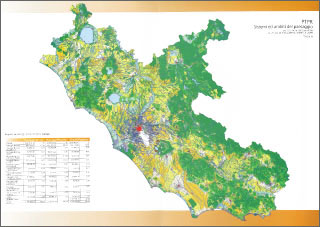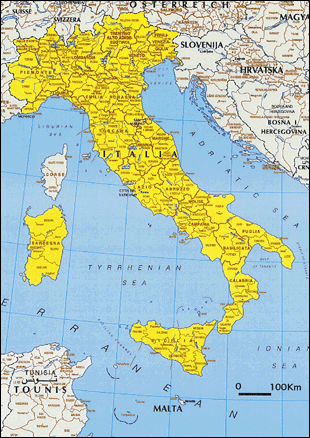Country Profile
Although Italy is comparable to Japan in terms of size, with a land area of approximately 300,000 km², it is approximately half of Japan in population. Even so, its population of approximately 60 million ranks fourth in the European Union after Germany, France and United Kingdom. It is one of the most densely populated countries in Europe. The fact that Italy has historically maintained close relationships with the Mediterranean countries due to its geographical location has shaped its regional characteristics and history. In northern Italy, while the so-called industrial triangle formed by Milan, Turin and Genova is the center of economy, Rome and Florence are the centers of tourism and politics. Agriculture remains the main industry in southern Italy, prompting calls for the modern development of the area.
TableItaly fast facts
| Country name | Republic of Italy |
|---|---|
| Surface area | About 301,000 km² (about four-fifths of that of Japan) |
| Population | 60.7 million (2016) |
| Population density | 202/km² |
| Percentage of urban population | 69% (2015) |
| GDP | USD 18,158 billion (2015: IMF) |
| GDP per capita (nominal) | USD 29,867 (2015: IMF) |
| Percentage of employment by industry | agriculture: 3.9% industry: 28.3% services: 67.8% (2011) |
| Economic growth rate (real) | 0.6% (2011), ▲2.8% (2012), ▲1.7% (2013) ▲0.4% (2014), ▲0.8% (2015) (IMF) |
(Information Updated: March 2017)
Local Governments
The local governments of Italy are three tiered, comprising regions (regione: 15 regular regions and 5 special regions totaling 20 regions), provinces (provincia: 110), and municipalities (commune: 8,101). Although approximately half of Japan in population, Italy has a large number of autonomous provinces and municipalities. In other words, it can be said that the country has a long and stable history of autonomous bodies.
The authorities of the central government were partially transferred to the regions, which were established one by one after 1970. Further, the relationships among various local bodies were revised by the constitutional amendment of 2001, as a result of which Metropolitan Area (Citta' metropolitana) was added as a new form administrative division. Spatial planning is essentially led by the regions, with the central government providing financial support and providing advices, including coordination. The urban policies of Italy are characterized by local level planning led by the regions. Local plans developed by the regions, the primary objectives of which are local development and the preservation of local resources, have secured the highest standing among statutory urban plans, whiles making adjustments for coordination with the statutory basic urban plans of the local autonomous bodies.
Major Authorities Relating to Spatial Policy
| Policy Area | Authority | Web Site |
|---|---|---|
| Infrastructure, transportation | Ministry of Infrastructure and Transportation: Ministero delle Infrastrutture e dei Trasporti |
http://www.mit.gov.it/mit/site.php |
| Culture, environment | Ministero dei Beni e delle attività Culturali e dei turismo | http://www.beniculturali.it/mibac/ export/MiBAC/ |
| Local economic development | Ministry of Economic Development: Ministero dello Sviluppo Economico |
http://www.sviluppoeconomico.gov.it/ |
| Regional local policy | Lazio Region: Regione Lazio |
http://www.regione.lazio.it/web2/ contents/ptpr/ |
Local issues in Italy have been resolved in accordance with the Urban Planning Law legislated in 1942. The urban master plans devised pursuant to the Urban Planning Law have been already been adopted by municipalities nationwide, which have recently been entering a period for review. Following the establishment of regions beginning in 1972, the authority to approve urban plans have been transferred completely to the regions. There are moves in the developed areas for the regioal governmenment to legislate its own regional laws in order to address local growth management and preservation of the environment, which require prompt attention.
Major Present-Day Tools Relating to Spatial Planning
The promotion of the spatial and regional development policies of Italy has been focused on the economic aspect of redressing the disparities between southern and northern Italy ever since the unification of Italy in 1861. Beginning with the first long-term economic plan for the 1965-70 period, the development of the economically inferior southern Italy has been incorporated into the plan as a national economic policy.
Italy does not have higher level spatial plans that supercedes regional plans, such as natioinal spatial plan. Plans of a national scale are limited to highway, railroad, and similar plans. In response to the regional policies of the EU, Italy has been implementing a national fund allocation program since the 1990s based on plans transcending national territory and the Structural Fund.
Table:Major Plans Related to Spatial and Regional Arrangement
| Plan | Authority |
|---|---|
| Regional Territorial Plan (PTR) | Region |
| Regional Territorial Landscape Plan (PTPR) | Region |
| Provincial Territorial Coordination Plan (PTCP) | Province or Metropolitan level |
| Metropolitan Area Plan (PRGI) | Province or Metropolitan level |
| Municipal Master Plan (PRG) | Municipality |
- Territorial Spatial Development System
- The basic framework of Italy for statutory urban plans subsequent to the decentralization of authority in 1990 pursuant to the New Local Autonomy Law is as follows in the order of decending priority: i) regional territorial plans (Piano Territoriale Regionale), ii) provincial territorial coordination plans (Piano Territoriale di Coordinamento Provinciale) and metropolitan area plans (PRGI), iii) municipal (comune) master plans (PRG), and iv) district plans (PP).
- A territorial plan (PTR) is devised by each of the 20 regional governments as the topmost plan. A territorial plan covers regulations on particular land usage, the decvelopment of particular large land areas, and the planning of infrastructure such as road network and railways. The draft of a regional territorial plan is prepared with the participation of provinces, municipalities, private entities, and the like and are finalized by obtaining the approval of the regional assembly.
- Preservation of Regional Territorial Landscape Pursuant to the Galasso Act
- Aside from this framework for statutory urban plans, regional territorial landscape plans (Piano Territoriale Paesaggistico Regionale)pursuant to the Galasso Act (Legge Galasso: Emergency Legislation for Protection of Areas with High Environmental Value) legislated in 1985 are also important local development tools. Each regional government is required to formulate a landscape plan, which is widely incorporated into the regional territorial plan (PTR) subject to review in accordance with the environmental protection provisions. The Act was amended in 2004, and the Lazio Region prepared a landscape plan that satisfies the amended act. Landscape plans have become one of the important territorial plans devised by regional governments.
Relationship with EU's Measures
The Italy's central government is fulfilling its roles as a coordinator of EU policies and the country's regional policies. Regions also participate in the formulation of the national operating plan necessary for the use of the EU Structural Fund. The operating plan is devised concurrently with the regional spatial plan in alignment therewith. In fact, the regional spatial plans of the Lazio and Lombardia Regions are devised for the purpose of receiving the EU Structural Fund.
- Local Development Based on Urban Regeneration and Sustainable Territorial Development Program
- In response to the proposal of the European Parliament of March 1998 concerning the EU Structural Fund, the Ministry of Public Works established the Urban Rejuvenation and Sustainable Territorial Development Program (Prusst; Programmi di riqualificazione urbana e di sviluppo sostenibile del territorio) that same year. The Program promoted diversified investment in various areas, resulting in progress in the improvement of broad-area transportation systems connecting different regions, restoration of historical buildings, and the renovation or conversion of industrial facilities into mixed-use ones.
- This "Prusst" was extended to set out Hypothesis for the Perspective of Competitive and Sustainable Development (Ipotesi per una prospettiva di sviluppo competitivo e sostenibile) in November 2012. This hypothesis included establishment of Transport Network Development and Logistics Program to Enhance International Competitiveness.
Figure:Lazio Region Landscape Plan

Source: Regione Lazio "Piano Territoriale Paesistico Regionale"
Metropolitan Spatial Improvement Plan
The Lazio Region, which has a metropolitan area with a population of about 3 million centered around the capital city of Rome and its population of about 2.54 million, is promoting local-level planning pursuant to the provisions of the its regional laws legislated in 1999. Principal plans by area include the preservation of scenery, improvement of environment, management of rivers and other aquatic bodies, management of mining activities, and improvement of the transportation network. As an environmental preservation measure, a landscape plan was adopted in 2006 in the form of responding to the Galasso Act that was amended in 2004 and was positioned as a higher level plan among the urban plans of the city. A plan is under way to combine the territorial plan with the landscape plan to establish greenbelts in order to prevent the unregulated expansion of Rome.
Development of Southern Italy
Although there were eight regions subject to the EU Structural Fund (areas where the per capita GDP was no more than 75% of the average European GDP) in the 1994-1999 period, the number decreased to four (Campania, Puglia, Calabria, and Sicilia Regions) as a result of the expansion of the EU to include eastern Europe.
The purposes of the development of southern Italy are to enhance the competitive power of the south and enhance its production capability. To this end, traffic and transport infrastructures are required.
Of the 12.3 billion euros to be invested pursuant to the 2007-2013 national strategic framework, 85% will be allocated to the development of the south.
* The breakdown of the 12.3 billion euros is as follows: 2.87 billion euros from the EU Structural Fund, 3.11 billion euros from the country, 6.33 billion euros from the Fund for Underdeveloped Areas (FAS).
(Information Updated: March 2013)

